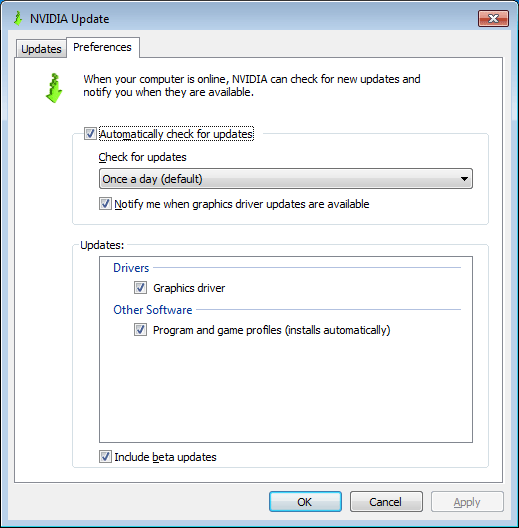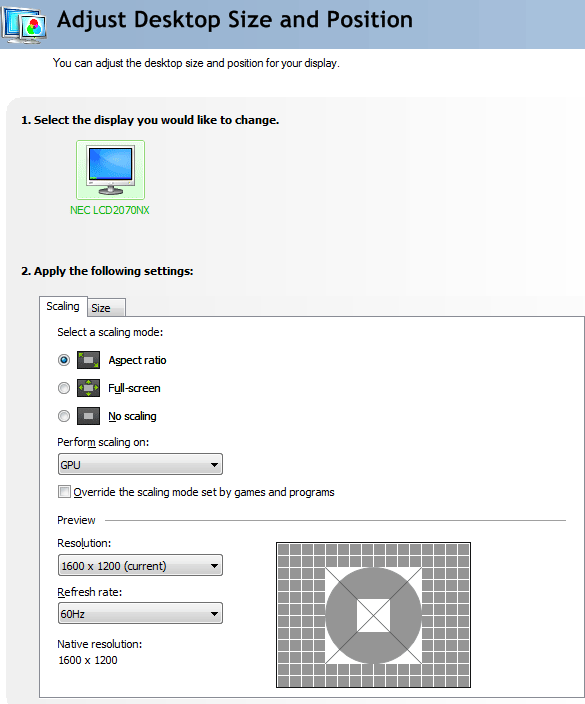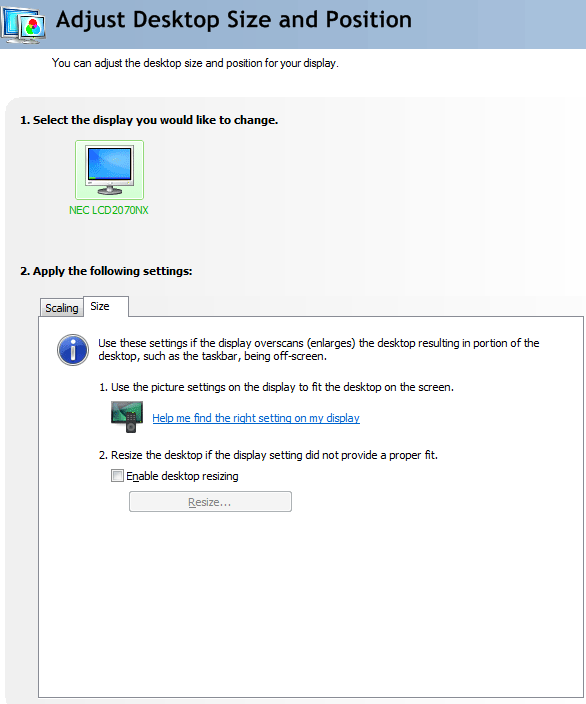NVIDIA's GeForce GTX 560: The Top To Bottom Factory Overclock
by Ryan Smith on May 17, 2011 9:00 AM ESTNew Release 275 Drivers & The Test
Launching alongside the GTX 560 will be the newest branch of NVIDIA’s GeForce drivers: Release 275 beta. This actually comes hot on the heels of Release 270, which came out only a month and a half ago.
Unlike Release 270 NVIDIA isn’t making a lot of performance promises, so this is mostly a feature release. The big item in 275 for most gamers will be further refinements to the auto-update mechanism first introduced in 270. NVIDIA has finally fully ported over Optimus’ auto-update feature, meaning that NVIDIA’s drivers can now automatically find and install profile updates in the background. However whereas Optimus profile updates were necessary for switchable graphics, for desktop users the primary purpose of auto-updating profiles is for SLI and anti-aliasing compatibility, as NVIDIA uses compatibility flags in their profiles to make those features work.

Automatic profile updates won’t completely absolve SLI from periods of incompatibility, but it should help. NVIDIA has released out of band profile updates for SLI before, but these were rather rare. If they now release profile updates much more frequently, then this will be a boon for SLI users, particularly GTX 295/590 users. Otherwise SLI is mostly limited by what can be done with a profile – if NVIDIA has to update the driver itself, then users will still need to wait for a new driver release. Which on that note, NVIDIA hasn’t changed the auto-update procedure for the drivers: profiles will auto-download and install, but driver updates must still be manually approved.
NVIDIA tells us that in the future they will also be able to deliver 3D Vision compatibility updates with profiles, but this will probably require a bit of a rearchitecting to their drivers and profiles. Currently NVIDIA’s profiles contain a few flags for 3D Vision (mainly whether it’s allowed), but there aren’t any sweeping compatibility bits as there are for SLI and AA.
Moving on, the other big functionality update with 275 is a new resizing and scaling UI in the NVIDIA control panel. The core functionality of scaling hasn’t changed much as NVIDIA has offered these controls for quite some time, but now scaling controls are available for VGA and HDMI displays, versus just DVI and DisplayPort as it was previously. There’s also a new override option or Windows 7, for forcing misbehaving programs to use NVIDIA’s scaling options instead of their own. (Ed: We’ve never actually encountered this before. If you know of any games/applications that need this option, please let us known in the comments)

As for resizing, NVIDIA has tweaked the UI to help better guide users through using overscan correction and/or disabling overscan on their TVs. The ideal method of dealing with overscan is to disable it on the TV (thereby ensuring 1:1 pixel mapping), which is what NVIDIA now first directs users toward. For users that can’t disable overscan, they can then unlock NVIDIA’s resizing controls. NVIDIA tells us that they’ve also done some work to improve resizing compatibility for games/applications that try to force standard resolutions, but we have not had an opportunity to test this yet.

The Release 275 betas should be available later today, with WHQL drivers appearing within a month.
The Test
As we mentioned in our introduction, the lack of any reference-clocked cards means that the GTX 560’s clocks – and thereby the GTX 560’s performance – is not well rooted. As a result we’ve tested our ASUS GTX 560 DirectCU II Top at a few different clockspeeds. We’ve tested the card at NVIDIA’s reference clocks of 810/4004 (GTX 560 Base), along with the slowest "mid-grade" card on NVIDIA’s release list: 850/4104 (GTX 560 Mid). NVIDIA is pitching the GTX 560 as their $199 card, so for the purposes of our review we’ll be focusing primarily on the mid-clocked GTX 560, as this is the approximate speed of most of the $199 cards. If you buy a $199 GTX 560 today, this should closely represent the speed of the card you’re buying.
Ideally 810/4004 cards will be relegated to the OEM market, but if not we also have the base clocks included for appropriate consideration. It goes without saying that we’d rather NVIDIA just create two different product lines rather than having so many cards under the same umbrella, but at this point we’re just repeating ourselves.
We’ve also included our overclocking results with the ASUS GTX 560 DirectCU II Top, colored in orange. As we were only able to reach 950/4400, the performance gains are limited.
For drivers, on the NVIDIA side we’re using 275.20 beta for the GTX 560, the GTX 460 1GB, and GTX 560 Ti. In practice the average performance difference between release 275 and release 270 is around 1% in favor of 275. On the ATI side we’re using the Catalyst 11.5a hotfix; however do note that in our testing we’ve found that performance is identical to the 11.4 drivers.
| CPU: | Intel Core i7-920 @ 3.33GHz |
| Motherboard: | ASUS Rampage II Extreme (X58) |
| Chipset Drivers: | Intel 9.1.1.1015 (Intel) |
| Hard Disk: | OCZ Summit (120GB) |
| Memory: | Patriot Viper DDR3-1333 three x 2GB (7-7-7-20) |
| Video Cards: |
AMD Radeon HD 6970 AMD Radeon HD 6950 2GB AMD Radeon HD 6870 AMD Radeon HD 6850 AMD Radeon HD 5870 AMD Radeon HD 5850 AMD Radeon HD 5770 AMD Radeon HD 4870 NVIDIA GeForce GTX 580 NVIDIA GeForce GTX 570 NVIDIA GeForce GTX 560 Ti ASUS GeForce GTX DirectCU II Top NVIDIA GeForce GTX 550 Ti NVIDIA GeForce GTX 480 NVIDIA GeForce GTX 470 NVIDIA GeForce GTX 460 1GB NVIDIA GeForce GTS 450 NVIDIA GeForce GTX 285 NVIDIA GeForce GTX 260 Core 216 |
| Video Drivers: |
NVIDIA ForceWare 262.99 NVIDIA ForceWare 270.51 Beta NVIDIA ForceWare 275.20 Beta AMD Catalyst 10.10e AMD Catalyst 11.4 AMD Catalyst 11.5a |
| OS: | Windows 7 Ultimate 64-bit |










66 Comments
View All Comments
Grooveriding - Tuesday, May 17, 2011 - link
Would be nice to see a comparison of the 560 to the 460 both at the same clockspeeds.Looking at this review, they will perform exactly the same at the same clocks. But it would be nice to see the comparison none the less.
xxtypersxx - Tuesday, May 17, 2011 - link
I agree, it seems to be a pretty standard refresh except whereas 460's tend to top out around 850mhz, these make it much closer to 1ghz.I hope the all of the manufacturers learned their lesson from the rash of dying 460's a few months after launch and included heatsinks on the VRM's like Asus did. These GF114/GF104 cards draw too much current when overclocked for the manufacturer's to leave the mosfets naked as they did with most launch 460's.
I also liked how the clock scaling was presented in the review, this is a good way to handle the non-standardized speeds. I'm sure you'll get the standard comment whiners screaming bias, but at this point I'm convinced they will do this whenever you show an Nvidia card even power on correctly.
L. - Thursday, May 19, 2011 - link
I'm pretty sure they didn't learn too much, seeing what happened to tdp-control on the 590 ... (i.e. nerf the card else it's gonna blow up) - quite normal though, trying to put two 350 watt gpu's on the same board was a retarded idea, since it's not supposed to be a hairdryer.iGas - Sunday, July 10, 2011 - link
I agree.Would be nice to see a direct comparison clock for clock. And, perhaps a comparison with the 470, and 480 at base clock and OC.
PS. My MSI GTX 460, humming along perfectly at 940mhz (and it did broke into 1011mhz territory).
DarknRahl - Tuesday, May 17, 2011 - link
Larger resolutions would be handy.Stuka87 - Tuesday, May 17, 2011 - link
It would be interesting to see them tested on a 27" display, but most single card setups fall on their face at that resolution (2560 x 1440).L. - Thursday, May 19, 2011 - link
Well that's where you see AMD cards (2GB) get some more points.But as discussed .. makes more sense to have 2* 1080p instead, financially.
michaelheath - Tuesday, May 17, 2011 - link
Why? Nvidia pretty much said last week that the target market for the GTX560 was users who want an affordable card to play games at 1080p resolution. Who would buy a $200 graphics card to play on a $1000+ 2560 x 1440/1600 display anyway? If you have that much money in your pockets for a high-quality display, why would you skimp out on the graphics card?Ushio01 - Tuesday, May 17, 2011 - link
http://www.overclockers.co.uk/showproduct.php?prod...Only £440 ($660).
L. - Wednesday, May 18, 2011 - link
It is clearly dumb to think resolutions will stay at the same level for eleventy beelion years.Anyone who has a good monitor wants to make use of it and might want to know how it's going to work.
Besides, your 1000 bucks figure is like 3x the price for some of the cheapest 2560* .
And, 200 bucks is not exactly "skimping out" on the gfx ...